

TOVA PREVIEW : NEW 2nd GENERATION HONDA FIT/JAZZ
 Honda's most successful model of this decade the Honda Fit, also known as Jazz in some countries, has
undergone an FMC or Full Model Change. This is Honda's term for the launch of a new generation and the new
2nd Generation Fit had been launched for sale in the Japanese Domestic Market at the end of last week, on
the 27th of October 2007. This timing is no doubt to coincide with the biannual Tokyo Motor Show which
started early last week and will run over the next two weeks.
Honda's most successful model of this decade the Honda Fit, also known as Jazz in some countries, has
undergone an FMC or Full Model Change. This is Honda's term for the launch of a new generation and the new
2nd Generation Fit had been launched for sale in the Japanese Domestic Market at the end of last week, on
the 27th of October 2007. This timing is no doubt to coincide with the biannual Tokyo Motor Show which
started early last week and will run over the next two weeks.
While the launch was for the JDM, the Honda Fit/Jazz is one of the few Honda models that is a truly global model. By this, I mean that Honda did not go the very irritating way of having 'special versions' exclusive for the JDM, or by having different designs for different parts of the world. Other than some modifications which were necessary to meet certain countries domestic regulations, the 1G Fit/Jazz was basically the same design, no matter which country it was sold in. Honda seems to be particularly stubborn with their continued ignorance of this fact, but I believe I speak for the majority, if not all, hard-core Honda fanatics that having a unified global design for a model, especially one as excellent and popular as the Fit/Jazz is very important.
Thankfully, the hints I have received so far have led me to believe that this 2G Fit/Jazz will continue to be a unified global design, again with suitable modifications - if necessary - to meet certain countries' domestic regulations. So we can all look forward to this new 2G Fit/Jazz making its way outside of Japan, and across the world and especially to our own countries, over the next few months and years. Hopefully, I did not read the hints wrong.
This preview of the new 2nd Generation Fit/Jazz is written using the press materials from the Honda Motor Co. Ltd's media department while waiting for its launch here in Asia/Malaysia (hopefully not too long into the future) where I can finally check it out in the flesh.
Highlights of the new 2nd Gen JDM Honda Fit
 |
The new 2nd Gen Fit is a clear evolution, a development, on the outgoing 1st Gen Fit/Jazz. It makes perfect sense really, not to mess with a proven and extremely successful car. And so the new 2nd Gen Fit might even be seen as more or less a much improved 1st Gen Fit/Jazz. This evolutionary relationship is clearly seen from the exterior and interior design of the new 2nd Gen Fit/Jazz.
Exterior and Interior Designs
 Exteriorly, the 1G Fit/Jazz's basic elegantly aerodynamically flowing lines are continued on this new 2G
Fit/Jazz, suitably updated to match the latest design trends. This has made it more angular than the 1G
Fit/Jazz. The front 'A-pillars' are moved forward by 120mm and now forming a virtual single slopping front-end
in conjunction with the new design bonnet. The new bonnet/hood looks like an adaptation of that used on the
JDM Honda AIRWAVE wagon. As a result of the A-pillars moving forward, the front windscreen is now 1.2
times larger.
Exteriorly, the 1G Fit/Jazz's basic elegantly aerodynamically flowing lines are continued on this new 2G
Fit/Jazz, suitably updated to match the latest design trends. This has made it more angular than the 1G
Fit/Jazz. The front 'A-pillars' are moved forward by 120mm and now forming a virtual single slopping front-end
in conjunction with the new design bonnet. The new bonnet/hood looks like an adaptation of that used on the
JDM Honda AIRWAVE wagon. As a result of the A-pillars moving forward, the front windscreen is now 1.2
times larger.
The 2G Fit/Jazz design objectives continues to be based on Honda's proven man-maximum, machine-minimum principle. In Honda's own words from the press release, the objective when designing this new 2G Fit/Jazz is to 'create the ideal small car for a new age, providing values which exceeds customer expectations for a small car and to set a benchmark in the highly competitive small car (compact/B-segment) segment in terms of packaging, utility and driving performance.' These goals are actually virtually the same as those of the outgoing 1G Fit/Jazz and which that car truly excelled in acheiving. So the new 2G Fit/Jazz really seeks to further advance them. In this respect, the outgoing 1G Fit/Jazz had set a truly remarkable standard, an extremely high benchmark which this new 2G Fit/Jazz will have its work cut out to even just try to match, what more to exceed. The best people to judge whether this new 2G Fit/Jazz has met its extremely tough goals are no doubt the Fit/Jazz's over 2 million owners and fans worldwide. So whether it will succeed and by how much it will succeed, Honda fans and especially Honda Fit/Jazz fans around the world will be eagarly waiting to make the judgement over the next few months as it gets launched around the world.
| The new interior looks very familiar |
The 2G Fit/Jazz continues to exploit the innovative center (fuel-)tank layout and as normal from a Honda FMC, features a longer wheelbase (+50mm) and wider treads/tracks for the front and rear wheels (+30mm for front and +35mm for rear). The exterior of the car is 55mm longer and 20mm wider but retains the same height. More crucially, the turning radius of the car is kept the same at 4.7m. In the interior, surprisingly Honda is reporting a 10mm reduction in the length of the cabin space though there is a 10mm increase in cabin height. This is particulary dissapointing as the interior of the 1G Fit/Jazz was exceptional for its class and had Honda increased the interior by just a bit more, the 2G Fit/Jazz would really start to challenge the interior space of many cars from the next bigger class !
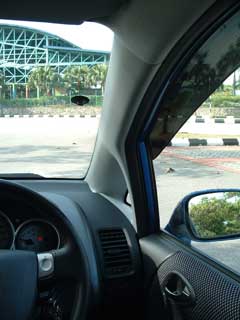 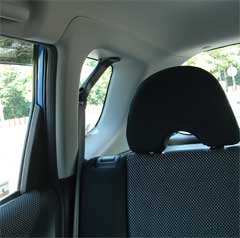 |
Front and rear views of the 1G Fit/Jazz from the driver's seat, showing clearly the restricted visibility and are two of the very few weaknesses of the 1G Fit/Jazz. |
For its class, the 1G Fit/Jazz truly had very few weaknesses. But it's not perfect of course. One important weakness of the 1G Fit/Jazz's interior was its visibility, in particular when looking out from the driver's seat. The very thick front and rear pillars are necessary for ensuring the structural strength and thus safety of the car but unfortunately they also interfere with the visibility. As explained in my Jazz VTEC full review, there are two major blindspots from inside the 1G Fit/Jazz. First is the forward-right angular view, between 12 and 2 o'clock when looking out from the driver's seat. The tiny front quarter windows (on either side of the dashboard) and very thick front 'A' pillars creates a huge blind-spot here and as explained in my review, often small vehicles, motorbikes & bicycles and even pedestrains can become virtually 'invisible' especially when turning right. Honda made an effort to address this blindspot in the new 2G Fit/Jazz. The press release says that the front quarter windows on the new 2G Fit/Jazz is 3 times the size of the old ones while the front 'A' pillars are 20mm thinner. These should combine to reduce the front-right blindspot.
 |
| 2G Fit/Jazz features 3 points to enhance visibility |
All cars have blindspots of course. But I am an owner and a big fan of the 1G Fit/Jazz. So while these 2 blindspots of the 1G Fit/Jazz are not fatal weaknesses, I would expect Honda to deal with them, at least minimize them in the new 2G Fit/Jazz. How effectively Honda has fared in dealing with these two blind-spots will definitely be one of the most important items on my checklist when the car gets launched here in Malaysia.
Utility
 The 1G Fit/Jazz established a huge reputation for it's incredible class-leading utility and Honda has
further enhanced this in the 2G Fit/Jazz. Most importantly, Honda had smartly retained the Ultra-Seats.
When HRT removed the Ultra-Seats from the Honda City 1.5VTEC in its mid-life MMC, there were many
negative comments from fans. I am still not sure what rationale Honda used for removing the Ultra-Seats
but everyone I have talked to agreed that it was the wrong rationale. For a while, when spy-photos
of the 2G Fit/Jazz started leaking out onto the internet, there were concerns the Ultra-Seats will
similarly be deleted as well. Thankfully the press release confirms that sensibility has prevailed. The
Ultra-Seats remains in this new 2G Fit/Jazz and that means it continues to offer the 4-modes of Utility,
Long, Tall and Refresh. As these are the same modes, acheived through virtually identical configurations
of the front and rear seats as with the 1G Fit/Jazz, we shall not go through them again. The rear doors
now opens a little wider as well, to a wide 80 degrees angle which offers enhanced accessibility when
loading bulky objects into the rear seat space.
The 1G Fit/Jazz established a huge reputation for it's incredible class-leading utility and Honda has
further enhanced this in the 2G Fit/Jazz. Most importantly, Honda had smartly retained the Ultra-Seats.
When HRT removed the Ultra-Seats from the Honda City 1.5VTEC in its mid-life MMC, there were many
negative comments from fans. I am still not sure what rationale Honda used for removing the Ultra-Seats
but everyone I have talked to agreed that it was the wrong rationale. For a while, when spy-photos
of the 2G Fit/Jazz started leaking out onto the internet, there were concerns the Ultra-Seats will
similarly be deleted as well. Thankfully the press release confirms that sensibility has prevailed. The
Ultra-Seats remains in this new 2G Fit/Jazz and that means it continues to offer the 4-modes of Utility,
Long, Tall and Refresh. As these are the same modes, acheived through virtually identical configurations
of the front and rear seats as with the 1G Fit/Jazz, we shall not go through them again. The rear doors
now opens a little wider as well, to a wide 80 degrees angle which offers enhanced accessibility when
loading bulky objects into the rear seat space.
The rear boot/trunk space of the 1G Fit/Jazz was really quite exceptional for the car's size and I have often been surprised by how much stuff it can swallow. In the new 2G Fit/Jazz, Honda improved it further, liberating an extra 64 liters of storage space through removing the spare tyre (replacing it with an emergency tyre repair kit). This makes the boot size now 427 liters in total volume !
 |
| The new 'Ultra-Luggage Boot' of the 2G Fit/Jazz |
 To maximize the impact of this extra space, the rear hatch sill is now only 605mm (~2feet) from the
ground so making the loading of heavy unweildy stuff easier. However one small limitation of the 1G
Fit/Jazz's rear boot is the opening size itself. If the rear seats are not folded, fitting some super
wide items into the boot can be difficult. It's not that they cannot fit inside the boot, they
can, but first we still have to get them into the boot space and the slightly small opening can
interfere
if the item is unusually long. So the problem is not in the available boot size but rather with
the size of the opening of the rear hatch. So in cases like this, the rear seats have to be folded
down first and the super-wide item manuevered length-wise into the rear boot. After successfully
putting the item into the boot proper, only can the rear seats be
lifted back to their upright position. Besides the extra steps involved, this also means planning is
needed when loading a lot of items, especially if the tall mode is also needed. So in such
cases, the super-wide items will need to be loaded in first as the rear seats needs to be folded
down. Once loaded, the rear seats are lifted back upright before the seat supports lifted to get into
tall-mode to load the rest of the items into the rear seat space. This important point on the new
2G Fit/Jazz cannot be ascertained until the actual unit is checked.
To maximize the impact of this extra space, the rear hatch sill is now only 605mm (~2feet) from the
ground so making the loading of heavy unweildy stuff easier. However one small limitation of the 1G
Fit/Jazz's rear boot is the opening size itself. If the rear seats are not folded, fitting some super
wide items into the boot can be difficult. It's not that they cannot fit inside the boot, they
can, but first we still have to get them into the boot space and the slightly small opening can
interfere
if the item is unusually long. So the problem is not in the available boot size but rather with
the size of the opening of the rear hatch. So in cases like this, the rear seats have to be folded
down first and the super-wide item manuevered length-wise into the rear boot. After successfully
putting the item into the boot proper, only can the rear seats be
lifted back to their upright position. Besides the extra steps involved, this also means planning is
needed when loading a lot of items, especially if the tall mode is also needed. So in such
cases, the super-wide items will need to be loaded in first as the rear seats needs to be folded
down. Once loaded, the rear seats are lifted back upright before the seat supports lifted to get into
tall-mode to load the rest of the items into the rear seat space. This important point on the new
2G Fit/Jazz cannot be ascertained until the actual unit is checked.
Model Line-Up

The new 2nd Gen Fit continues to come in two major variants for the JDM, again centered on the 1.3l L13A and 1.5l L15A engines. The 1.3l variant comes in 2 main types, the Type L and Type G. Like before, they come with 2 choices of drivetrain layout, either FF or 4WD. The 4WD variant is only available in Japan and is for winter use, on slippery roads and works similarly to the rt-4WD on the CR-V and others. I.e. on slippery roads when the front wheels loses grip, power is transfered via a viscous coupling clutch to the rear wheels. With the 4WD drivetrain, a 5AT transmission is used while the FF continues to use the excellent CVT gearbox. Specs-wise, both Type L and Type G are actually identical for all purposes and their main difference is in the accessories.
For the new 2nd Gen Fit/Jazz, Honda has learnt their lessons well and right from the beginning have also launched a 'performance variant' of the 2nd Gen Fit. This is the Fit RS (RS standing for Road Sailing) and is fitted with the 1.5l L15A engine. It's designed pretty much to be the 'sports version' of the new Fit/Jazz with large 16" wheels, sporty front-grille and bodykit and the option of the 5AT (4WD) or when FF, either the CVT or a close ratio, highly geared 5MT gearbox (with a final drive of 4.294 !).
Updated Engines and CVT Gearbox
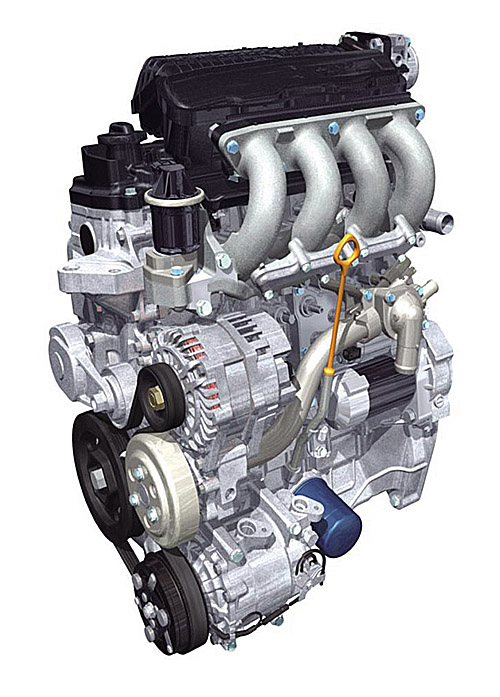 Both L13A and L15A engines have been further developed using new technologies and Honda is now calling them
'i-VTEC engines'. Thus the painstakingly developed innovative i-DSI technology has been removed from the new 2nd
Gen Fit. To me, this is an astonishing and surprising step because clearly a lot of R&D went into
developing what is clearly a unique and very effective technology. But
sadly it only lasted 1 generation on the Fit/Jazz.
Both L13A and L15A engines have been further developed using new technologies and Honda is now calling them
'i-VTEC engines'. Thus the painstakingly developed innovative i-DSI technology has been removed from the new 2nd
Gen Fit. To me, this is an astonishing and surprising step because clearly a lot of R&D went into
developing what is clearly a unique and very effective technology. But
sadly it only lasted 1 generation on the Fit/Jazz.
As is the norm now, Honda's i-VTEC does not necessarily mean VTEC+VTC. Rather the use of i-VTEC by Honda nowadays signifies an 'intelligent engine that exploits the VTEC technology and may or may not be backed by additional complementary technologies (like VTC or dual intake manifold, etc)'. Note that this definition is my own.
The 'L13A i-VTEC' is now 16-valves, still SOHC in configuration and features a 12V/16V VTEC implementation similar to the L15A VTEC on the out-going 1st Gen Fit/Jazz. Power has gone up by slightly over 16% to 100ps (from 86ps on the old i-DSI L13A) coming at a much higher 6000rpm (which also means the red-line is now above 6000rpm which is more appropriate for a high-technology Honda engine), with a higher max-torque of 13.0kg/m and coming at a high 4,800rpm (compared to 12.1kgm coming in at 2,800rpm). So the new L13A does not offer the good low-end torque of the original i-DSI L13A. But it still offers a lot more power plus more torque, but at higher rpms. The old L13A i-DSI was rated at 20-23km/l (depending on variant and type) in the standard japanese 10-15 mode fuel economy test. The new one is rated at 21.5 to 24 km/l (again depending on variant and type) and so on Honda's own data at least, they have made the new L13A i-VTEC more power as well as slightly more fuel economical than the old L13A i-DSI.
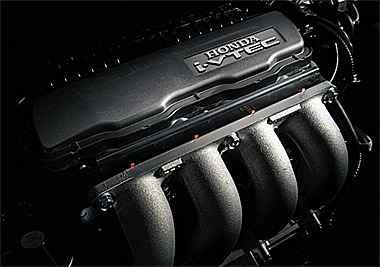 The L15A 'i-VTEC' has been developed from the L15A VTEC used on the out-going 1st Gen Fit/Jazz.
For the new Fit, it has been retrofitted with the full 16V 'power-VTEC' system similar to the older D15B
VTEC engines. To recap, this means the L15A i-VTEC runs 16V full-time. VTEC, like that used on the
previous D-series engines is now used on this L15A. When the conditions require it (note that i-VTEC now
means the L15A i-VTEC switches VTEC based on more sensors than the older D15Bs), VTEC activates a 'wild'
or 'high' cam-lobe and this increase the valve lift, duration and other timing parameters to allow more
air-flow into the combustion chambers - and thus more power to be generated. Power output has gained 10ps,
raising its max power to 120ps from the 110ps of the old L15A VTEC. Max torque has similarly gained but to
a much smaller extent, increasing from 14.6kgm to 14.8 kgm and coming in at the same 4,800rpm. More
significantly is its ability to rev higher, the power now peaking at a much higher 6600rpm and the redline
at 6800rpm, almost hitting 7000rpm. Now we are talking ! Nevertheless, this L15A i-VTEC is
still not equaling the power output of the D15B VTEC as that engine was spec'ed for 130ps and so the L15A
is still 10ps in deficit. Also the redline of the D15B VTECs were over 7000rpm (almost 7300rpm) so the L15A
i-VTEC while revving much higher than before, is still not yet at the level of the old D15B VTECs in terms
of outright power delivery (though of course it is a much more advanced engine especially in emissions).
The L15A i-VTEC is rated at a max of 19.6 (for the FF CVT) though Honda also quotes a second 'typical'
value of 18.8km/l (probably for more prevailing conditions). However, this figure is actually slightly
worse than that for the outgoing L15A VTEC of the 1G Fit/Jazz which was 20.0km/l so it would seem that
the extra 10ps power do come with a slight penalty in fuel consumption.
The L15A 'i-VTEC' has been developed from the L15A VTEC used on the out-going 1st Gen Fit/Jazz.
For the new Fit, it has been retrofitted with the full 16V 'power-VTEC' system similar to the older D15B
VTEC engines. To recap, this means the L15A i-VTEC runs 16V full-time. VTEC, like that used on the
previous D-series engines is now used on this L15A. When the conditions require it (note that i-VTEC now
means the L15A i-VTEC switches VTEC based on more sensors than the older D15Bs), VTEC activates a 'wild'
or 'high' cam-lobe and this increase the valve lift, duration and other timing parameters to allow more
air-flow into the combustion chambers - and thus more power to be generated. Power output has gained 10ps,
raising its max power to 120ps from the 110ps of the old L15A VTEC. Max torque has similarly gained but to
a much smaller extent, increasing from 14.6kgm to 14.8 kgm and coming in at the same 4,800rpm. More
significantly is its ability to rev higher, the power now peaking at a much higher 6600rpm and the redline
at 6800rpm, almost hitting 7000rpm. Now we are talking ! Nevertheless, this L15A i-VTEC is
still not equaling the power output of the D15B VTEC as that engine was spec'ed for 130ps and so the L15A
is still 10ps in deficit. Also the redline of the D15B VTECs were over 7000rpm (almost 7300rpm) so the L15A
i-VTEC while revving much higher than before, is still not yet at the level of the old D15B VTECs in terms
of outright power delivery (though of course it is a much more advanced engine especially in emissions).
The L15A i-VTEC is rated at a max of 19.6 (for the FF CVT) though Honda also quotes a second 'typical'
value of 18.8km/l (probably for more prevailing conditions). However, this figure is actually slightly
worse than that for the outgoing L15A VTEC of the 1G Fit/Jazz which was 20.0km/l so it would seem that
the extra 10ps power do come with a slight penalty in fuel consumption.
Over the lifetime of the Fit/Jazz (and the City), the CVT gearbox though giving excellent service, has frequently been the brunt of numerous rumours. These rumours centered on the supposed unreliability of the gearbox. I have done extensive research on these rumours and while I know of several real cases of CVT gearbox failures, I must emphasize that the number of occurrences are still relatively small, certainly about the same frequency as normal automatic or even manual gearboxes. Nevertheless, with lessons learnt from the very successful use of the MMT (which is of a very similar design to the CVT) on the new JDM Honda Odyssey, the CVT on the new 2nd Gen Fit is now equipped with a newly developed torque converter. This probably also means that the CVT no longer utilizes the infamous 'start-up clutch' though I have to talk to a Honda R&D engineer to confirm this. This torque converter is of similar design to those used on the latest generation of 5ATs, on the Civic in particular and from 1st hand experience, I know they are very efficient in design with much reduced power loss characteristic. So the new torque-converter equipped CVTs should be even better to drive than the already excellent CVTs used on the outgoing 1st gen Fit/Jazz. I can't wait for Honda Malaysia to launch the new Jazz here in Malaysis so I can get a chance to check out the new CVT gearbox to see if it delivers the goods.
Conclusion - A Suspended Verdict
| Advertisement |
|---|
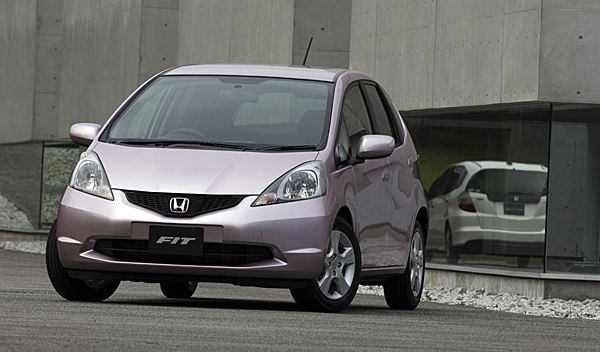 In itself, the new 2G Fit/Jazz is truly an excellent vehicle. But its ultimate success with its
many fans across the world still remains to be seen. It's biggest problem is not with the competition
however, but really is that the 1G Fit/Jazz was such an excellent vehicle. And this quickly puts
the new 2G Fit/Jazz under tremendous pressure. Simply, the 1G Fit/Jazz has set an extremely high standard
and the 2G Fit/Jazz must exceed this standard if it is to succeed. Unforunately Honda's record (and that
of many other manufacturers for that matter) of following up a run-away success with even a worthy
successor has not always been exemplary.
In itself, the new 2G Fit/Jazz is truly an excellent vehicle. But its ultimate success with its
many fans across the world still remains to be seen. It's biggest problem is not with the competition
however, but really is that the 1G Fit/Jazz was such an excellent vehicle. And this quickly puts
the new 2G Fit/Jazz under tremendous pressure. Simply, the 1G Fit/Jazz has set an extremely high standard
and the 2G Fit/Jazz must exceed this standard if it is to succeed. Unforunately Honda's record (and that
of many other manufacturers for that matter) of following up a run-away success with even a worthy
successor has not always been exemplary.
The Honda NSX is a good case in point. It was launched back in 1990, over 17 years ago and as of this moment, it is not even being produced or sold by Honda anymore. But Honda has yet to come out with a successor, despite its huge army of fans eagerly waiting for it. Many of us are in fact having the suspicion that the original classic NSX is such a stupendously excellent vehicle that Honda just could not design a replacement for it that they themselves feels satisfied with. Bulldozing a replacement in can and have led to disaster. With due apologies to CR-X Del-Sol fans, the 2G EF6-EF8 CRX were, like 1G Fit/Jazz, such excellent vehicles that the CR-X Del-Sol were not able to deliver a significant improvement. While the Del-Sol had its own fan-base, legions of CR-X fans unfortunately stayed away. The result was such a drop in sales volume that Honda canned the entire CR-X line-up. Till today, everytime I bring up the case for a CR-X revival, citing the CR-X as being one of the best loved of Honda models, I am rebutted with a reminder that the CR-X Del-Sol sold so poorly that Honda had to cancel the line-up.
The Fit/Jazz has already became one of Honda's core models, in terms of sales and in terms of continuing to establish Honda's reputation was being able to design class-leading cars. So with the Fit/Jazz, Honda cannot play the procastination game as they are doing with the NSX. Excellent though the 1G Fit/Jazz was, its competitors are slowly but surely catching up and Honda has to launch the new 2G Fit/Jazz. It's now or never. So the crucial question on millions of Honda enthusiast's mind is now whether the 2G Fit/Jazz has met the cut and is an able replacement for its outstanding predecessor. It's not going to be an easy task and Honda must ensure that the 2G Fit/Jazz offers more than just basically comestic updates and that the updates to the engine and gearbox will deliver a clear step-up. If not, then the 2G Fit/Jazz basically becomes just another MMC (and the 1G Fit/Jazz had undergone enough MMCs already over its 6.5 years life-span).
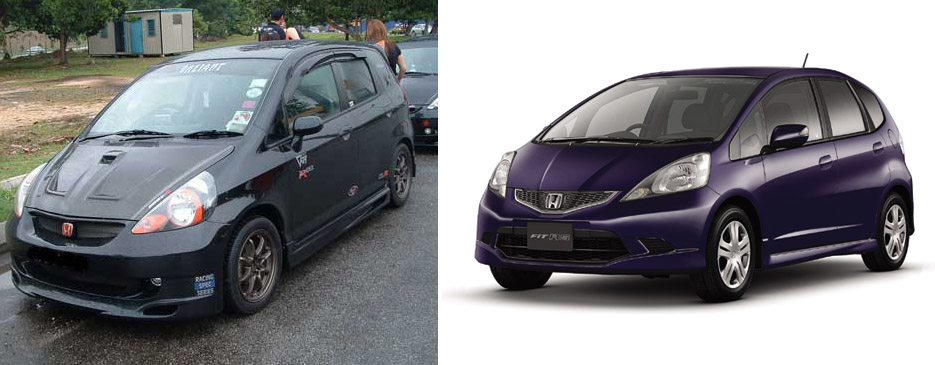 There is another problem. As the new model's launch nears for individual countries, existing units of
1G Fit/Jazz might be offered with special discounts or financing schemes. This is simply the most common
means to quickly clear existing stocks as news of the new model becomes readily available (and especially
so with the advent of the internet). So the question now becomes 'will a 1G Fit/Jazz be a good
buy or will it be worthwhile to wait for the launch of the new 2G Fit/Jazz ?' Generally a new generation
will be better than the outgoing one. But it will also be more expensive. And with the end-of-life discount,
the difference in price between a 1G Fit/Jazz and the 2G Fit/Jazz might be quite significant. And the
amount saved, for the enterprising enthusiasts, can come in very handy indeed. Buy a 1G Fit/Jazz and
with the money saved, change the stock wheels, fit in a 'fierce' bodykit and put in some nice mods and the
car have every chance of becoming more attractive than the new model ! So the issue again is that such is the
excellence of the 1G Fit/Jazz, will the 2G Fit/Jazz offer enough upgrade to justify foregoing a good deal
and waiting for it or even to put in an advanced booking before it is launched ? Don't forget that while
the 2G Fit/Jazz is a new model, it will still be basically fighting in stock form against a truly
excellent though older model that will be modified ! These are very valid questions and are questions
that I am regularly asked by TOVA readers. And these questions unfortunately I cannot answer and the
fairest answer I can give is for readers to simply wait and see.
There is another problem. As the new model's launch nears for individual countries, existing units of
1G Fit/Jazz might be offered with special discounts or financing schemes. This is simply the most common
means to quickly clear existing stocks as news of the new model becomes readily available (and especially
so with the advent of the internet). So the question now becomes 'will a 1G Fit/Jazz be a good
buy or will it be worthwhile to wait for the launch of the new 2G Fit/Jazz ?' Generally a new generation
will be better than the outgoing one. But it will also be more expensive. And with the end-of-life discount,
the difference in price between a 1G Fit/Jazz and the 2G Fit/Jazz might be quite significant. And the
amount saved, for the enterprising enthusiasts, can come in very handy indeed. Buy a 1G Fit/Jazz and
with the money saved, change the stock wheels, fit in a 'fierce' bodykit and put in some nice mods and the
car have every chance of becoming more attractive than the new model ! So the issue again is that such is the
excellence of the 1G Fit/Jazz, will the 2G Fit/Jazz offer enough upgrade to justify foregoing a good deal
and waiting for it or even to put in an advanced booking before it is launched ? Don't forget that while
the 2G Fit/Jazz is a new model, it will still be basically fighting in stock form against a truly
excellent though older model that will be modified ! These are very valid questions and are questions
that I am regularly asked by TOVA readers. And these questions unfortunately I cannot answer and the
fairest answer I can give is for readers to simply wait and see.
Unfortunately, the Temple Of VTEC Asia as a media source still have not gain sufficient credibility with Honda to get invited to their very exclusive media trip to the Tokyo Motor Show. It's a pity because it would have given me the chance to check out and to test the new Fit. This would have proved crucial to answering some of the important points I have raised in this review. Nevertheless, TOV founder Jeff Palmer did attend the show as part of the contingent from AHM and so I plan to discuss with him and to get his feedback (if any) regarding the points I have raised and maybe answering some of them.
October 2005
© Temple of VTEC Asia
